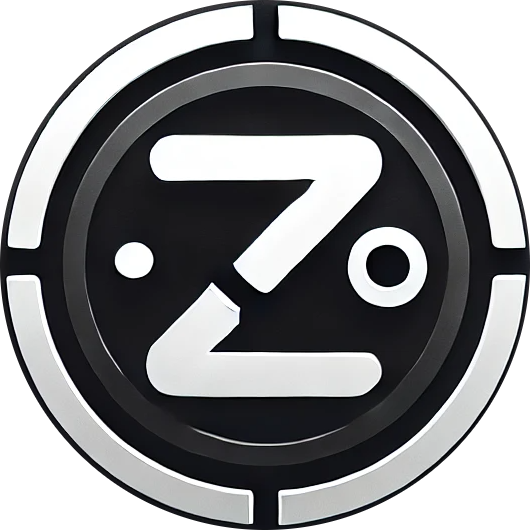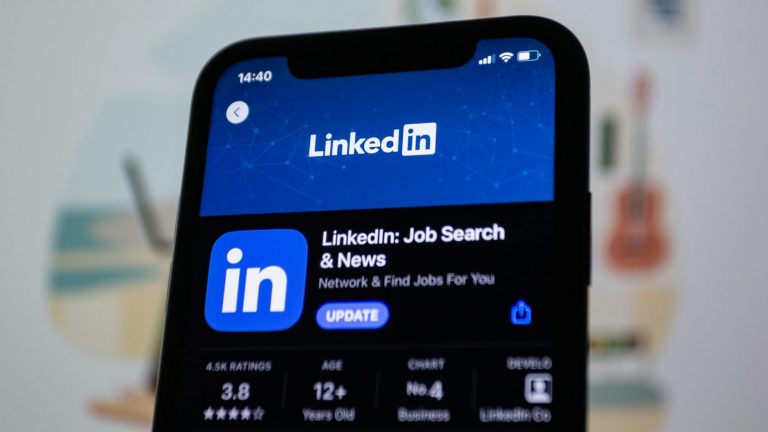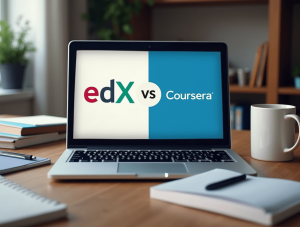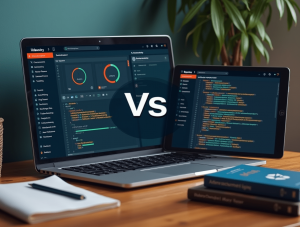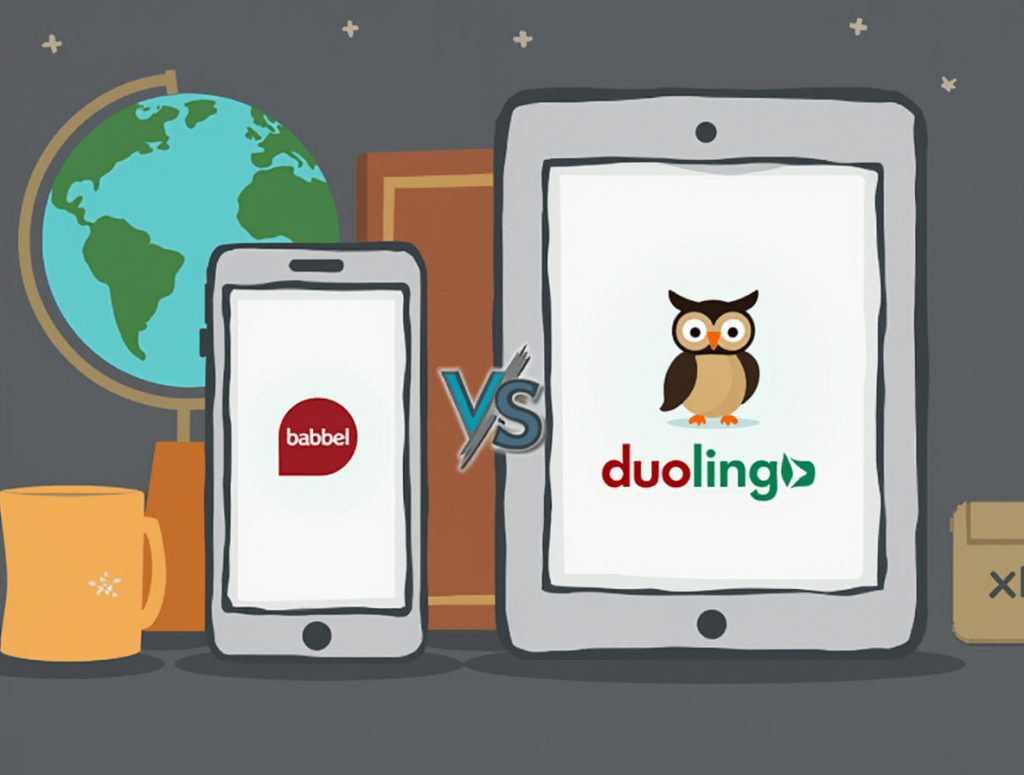
Which Language App Best Fits Your Learning Style
Did you know that learning a second language can improve decision-making skills and delay the onset of dementia by up to five years? As digital language learning surges in popularity, two platforms have emerged as frontrunners: Babbel and Duolingo.
If you’re struggling to choose between these popular language apps, you’re not alone. Both promise to transform you from a hesitant beginner to a confident speaker, but they take remarkably different approaches to language acquisition. One focuses on gamification and free access, while the other emphasizes structured curriculum and conversational practice.
In this comprehensive comparison, we’ll analyze both platforms across teaching methodologies, available languages, pricing structures, effectiveness, and user experience. By the end, you’ll understand exactly which platform aligns with your learning style, goals, and budget—helping you make the best decision for your language learning journey.
Language Learning Approaches: Fundamentally Different Philosophies
How Babbel Teaches Languages
Babbel approaches language learning with a traditional educational philosophy, enhanced by technology. Founded in 2007 by language learning experts and linguists, the platform focuses on:
Structured Curriculum Development
- Courses designed by professional linguists and language teachers
- Progressive difficulty that builds on previously learned concepts
- Lessons organized into practical, real-world conversation themes
Conversation-Based Learning
- Focus on dialogue and practical communication from day one
- Speech recognition technology to practice pronunciation
- Cultural context integrated throughout lessons
Cognitive Learning Techniques
- Spaced repetition system for vocabulary retention
- Grammar explained explicitly when relevant to communication
- Personalized review sessions based on performance
How Duolingo Teaches Languages
Duolingo takes a dramatically different approach, founded on gamification principles and bite-sized learning. Launched in 2011, the platform revolutionized language learning with:
Game-Like Learning Experience
- XP points, achievement badges, and competitive leaderboards
- “Streak” maintenance to encourage daily practice
- Visual rewards and level progression
Micro-Learning Format
- Short, 5-minute lessons designed for mobile consumption
- Skills organized into colorful “skill trees”
- Immediate feedback and correction
AI-Driven Adaptive Learning
- Algorithms that adjust difficulty based on performance
- Spaced repetition for vocabulary reinforcement
- Multiple choice, translation, and dictation exercises
Learning Philosophy Comparison
The fundamental difference between these platforms lies in their underlying approach:
- Babbel follows a more traditional language education model, focusing on conversational ability and practical use from the beginning. Its structure resembles what you might find in a well-designed classroom course.
- Duolingo pioneered the gamified approach, prioritizing user engagement and daily habit formation through psychological rewards and competitive elements.
This philosophical difference affects everything from lesson structure to motivation methods, creating distinctly different learning experiences.
Language Offerings and Content Depth
Babbel’s Language Selection
Babbel offers 14 languages (from an English speaker’s perspective):
- Spanish (Latin American & European)
- French
- German
- Italian
- Portuguese (Brazilian)
- Russian
- Polish
- Turkish
- Dutch
- Danish
- Norwegian
- Swedish
- Indonesian
Content Depth:
- 3,000+ hours of content across all languages
- Approximately 5,000 vocabulary words per language
- Cultural notes and regional dialect information
- Business-specific courses for major languages
Duolingo’s Language Selection
Duolingo offers significantly more languages with over 40 options, including:
- Popular choices (Spanish, French, German, etc.)
- Less commonly taught languages (Vietnamese, Ukrainian, Hawaiian)
- Constructed languages (Klingon, High Valyrian)
- Endangered languages (Navajo, Hawaiian)
Content Depth:
- Varies significantly between languages
- Popular languages have extensive content (3,000+ lessons for Spanish)
- Less common languages may have limited advanced material
- Approximately 2,000-3,000 vocabulary words for major languages
Language Offering Comparison
The platforms diverge significantly in their language coverage:
- Babbel offers fewer languages but maintains consistent depth and quality across its offerings. Each language receives full development attention.
- Duolingo prioritizes accessibility with its wide range of options, though content depth can vary dramatically between languages. Major languages receive regular updates and expansions, while specialty languages may have more limited content.
For learners of major European languages, both platforms offer comprehensive content. For those interested in less common languages, Duolingo may be the only option between these two services.
Pricing Models and Value Proposition
Babbel’s Subscription Model
Babbel operates exclusively as a premium subscription service:
Pricing Structure (as of April 2025):
- 1 month: $13.95/month
- 3 months: $9.95/month ($29.85 total)
- 6 months: $8.45/month ($50.70 total)
- 12 months: $6.95/month ($83.40 total)
What’s Included:
- Complete access to one language of your choice
- All lesson content and review materials
- Offline mode for learning without internet
- Speech recognition technology
- Personalized review manager
Additional Costs:
- Multi-language access requires separate subscriptions
- Live classes available for additional fees (Babbel Live)
Duolingo’s Freemium Approach
Duolingo pioneered the freemium model in language learning:
Free Tier:
- Complete access to all course content
- Ad-supported experience
- Five lives (mistakes) per day
- Limited testing options
Duolingo Plus/Super (Premium Tier):
- $12.99/month or $79.99/year ($6.67/month)
- Ad-free experience
- Unlimited hearts (attempts)
- Progress quizzes and mastery tracking
- Offline access
- Access to all languages simultaneously
Value Comparison
The pricing models reflect each platform’s fundamental philosophy:
- Babbel positions itself as a premium educational product, justifying its cost through instructor-designed content and structured pedagogy. The value proposition centers on quality and efficient learning.
- Duolingo emphasizes accessibility with its free tier, making language learning available to anyone with internet access. Its premium features focus on convenience and removing friction rather than providing exclusive content.
The better value depends entirely on your learning priorities:
- If budget is your primary concern, Duolingo’s free tier is unbeatable
- If learning efficiency and structured education matter most, Babbel’s subscription may provide better value despite the higher cost
Learning Experience and User Interface
Babbel’s Learning Experience
Lesson Structure:
- 10-15 minute focused lessons
- Clear progression from introduction to practice
- Dialogue-centric content with cultural context
- Grammar explanations integrated when relevant
User Interface:
- Clean, distraction-free design
- Professional appearance with muted colors
- Desktop and mobile versions with consistent experience
- Focus on content rather than gamification elements
Practice and Review:
- Spaced repetition review sessions
- Speaking exercises with speech recognition
- Writing and listening comprehension activities
- Personalized review based on error patterns
Duolingo’s Learning Experience
Lesson Structure:
- 5-minute bite-sized lessons
- Skill-based progression through a visual tree
- Varied exercise types within each skill unit
- Implicit grammar learning through pattern recognition
User Interface:
- Colorful, cartoon-style characters and animations
- Game-like elements throughout (points, gems, streaks)
- Mobile-first design optimized for quick sessions
- Notifications and reminders to maintain daily practice
Practice and Review:
- Spaced repetition through algorithmic selection
- “Legendary” levels for mastered skills
- Stories feature for reading comprehension
- Leaderboards and social comparison features
User Experience Comparison
The contrast in user experience reflects each platform’s core philosophy:
- Babbel creates a focused, distraction-free environment that resembles traditional language education enhanced by technology. The experience feels more like structured study than play.
- Duolingo embraces psychological engagement tactics, creating an addictive game-like experience designed to form daily habits. The approach emphasizes fun and accessibility over traditional educational structures.
These differences make each platform better suited to different learning preferences:
- Visual learners may prefer Duolingo’s colorful interface
- Focused, methodical learners often prefer Babbel’s cleaner approach
- Mobile-first users typically find Duolingo more convenient
- Those easily distracted might benefit from Babbel’s minimal design
Effectiveness and Results
Babbel’s Effectiveness
Independent Research:
- A 2016 City University of New York study found that 15 hours of Babbel usage equated to one college semester of language learning
- Michigan State University research showed 96% of users improved their language proficiency after two months
Strengths:
- Strong focus on practical conversation skills
- Explicit grammar instruction when needed
- Cultural context enhances communicative competence
- Speech recognition technology improves pronunciation
Limitations:
- Less emphasis on gamification may reduce daily engagement
- Requires more focused attention than bite-sized alternatives
- Limited community features for practice with others
Duolingo’s Effectiveness
Independent Research:
- A 2020 study found that 34 hours of Duolingo Spanish study was equivalent to one university semester
- Internal research showed significant improvement in reading and listening tests after consistent use
Strengths:
- Extremely effective at maintaining daily practice habits
- Strong vocabulary building through repetition
- Stories feature enhances reading comprehension
- Large user community provides motivation
Limitations:
- May develop translation habits rather than direct thinking in target language
- Less emphasis on speaking practice in real contexts
- Grammar rules often must be inferred rather than explained
- Game elements can sometimes distract from language acquisition
Effectiveness Comparison
Research suggests both platforms can be effective, but in different ways:
- Babbel excels at developing conversational ability and practical language use. Its structured approach tends to create more balanced language skills across speaking, listening, reading, and writing.
- Duolingo shines at building vocabulary and reading comprehension while maintaining high engagement. Its strength lies in forming consistent learning habits that lead to gradual improvement over time.
The effectiveness question ultimately depends on your definition of success:
- For basic tourist-level communication: Both are effective
- For conversational fluency: Babbel typically produces better results
- For reading comprehension: Both perform well
- For maintaining consistent practice: Duolingo’s engagement features excel
Ideal User Profiles: Who Benefits Most From Each Platform?
Who Should Choose Babbel?
Serious Language Learners If you have specific goals like business communication or living abroad, Babbel’s practical conversation focus and structured curriculum provide more efficient preparation for real-world use.
Adult Learners with Previous Language Experience Those who have studied languages in traditional settings often appreciate Babbel’s familiar educational approach, explicit grammar explanations, and focus on practical application.
Goal-Oriented Learners If you prefer a clear learning path with measurable progress toward specific competencies, Babbel’s structured curriculum provides a more straightforward roadmap to proficiency.
Those Willing to Invest Financially Learners who view language acquisition as a valuable skill worth financial investment often find Babbel’s premium-only model justified by its efficient, well-designed curriculum.
Who Should Choose Duolingo?
Casual Learners and Beginners Those exploring languages for fun or just starting their language journey benefit from Duolingo’s low-pressure, game-like approach that builds confidence gradually.
Budget-Conscious Learners If cost is a significant factor, Duolingo’s comprehensive free tier offers remarkable value and can take you quite far, especially in vocabulary building and basic comprehension.
Busy People Seeking Micro-Learning Learners with unpredictable schedules appreciate Duolingo’s bite-sized lessons that can be completed in spare moments throughout the day without requiring dedicated study sessions.
Motivated by Games and Competition If traditional education models feel boring or unmotivating, Duolingo’s gamification elements provide the psychological rewards that keep many learners consistently engaged.
Maximizing Success on Either Platform
Tips for Babbel Success
- Schedule Regular Sessions: Unlike Duolingo’s bite-sized approach, Babbel works best with dedicated 15-30 minute sessions.
- Use Speech Recognition Features: Babbel’s pronunciation tools are among its strongest features—use them consistently to develop authentic pronunciation.
- Complete Review Sessions: The personalized review manager identifies your weak points; don’t skip these sessions even when tempted.
- Supplement with Real Media: Complement Babbel’s structured lessons with authentic content like podcasts and TV shows in your target language.
- Focus on One Language: Since Babbel requires separate subscriptions for each language, commit to one language at a time for best value and focus.
Tips for Duolingo Success
- Set a Reasonable Daily Goal: The default 5-minute goal may be too low; challenge yourself with the 15 or 20-minute goal for more substantial progress.
- Use Timed Practice: Once you’ve completed lessons, the timed practice feature provides more challenging review that develops fluency.
- Read the Sentence Discussions: When confused about grammar or vocabulary, check the sentence discussions where community members often explain rules better than the app itself.
- Utilize the Stories Feature: These provide more context and natural language use than standard lessons and are excellent for developing comprehension.
- Supplement with Grammar Resources: Since Duolingo doesn’t explicitly teach grammar, keep a basic grammar reference handy to understand the patterns you’re learning.
Conclusion: Making Your Decision
The question “Which is better?” has no universal answer—both Babbel and Duolingo offer valuable language learning experiences designed for different types of learners.
Babbel provides a more traditional, structured approach to language learning with an emphasis on practical conversation skills and explicit instruction. Its premium-only model delivers a focused, professionally designed curriculum that efficiently builds real-world language competence. For serious learners with specific goals and a willingness to invest both money and dedicated study time, Babbel often provides faster progress toward functional proficiency.
Duolingo revolutionized language learning by making it accessible, engaging, and habit-forming through clever gamification. Its free tier offers remarkable value, while its premium features remove friction rather than gate content. For casual learners, beginners, or those with unpredictable schedules, Duolingo’s bite-sized approach maintains engagement and builds skills gradually over consistent daily practice.
Rather than asking which platform is universally better, consider these questions to guide your decision:
- What are your specific language goals? (Travel basics, business communication, fluency)
- How do you prefer to learn? (Structured education vs. game-like experience)
- What’s your budget for language learning tools?
- Which learning schedule fits your life? (Dedicated sessions vs. brief moments throughout the day)
- Which specific language do you want to learn? (Check availability and content depth)
Many successful language learners actually combine both platforms—using Duolingo for daily vocabulary practice and engagement, while turning to Babbel for structured conversation practice and more explicit instruction.
Whichever platform you choose, remember that consistent practice matters more than the specific tool. Both Babbel and Duolingo can help you reach your language goals if used regularly as part of a broader language learning strategy.
FAQ Section
How long does it take to become fluent using Babbel or Duolingo?
Neither platform alone will likely lead to complete fluency. Research suggests about 34 hours on Duolingo or 15 hours on Babbel approximates one university semester of language learning. True fluency typically requires 600-750 hours of study for easier languages (Spanish, French) and 1,500+ hours for difficult languages (Mandarin, Arabic). Both platforms should be viewed as tools within a broader language learning strategy that includes conversation practice with native speakers.
Can I switch between multiple languages on these platforms?
Duolingo allows unlimited language switching on both free and premium tiers. Babbel requires separate subscriptions for each language, making it less ideal for exploring multiple languages simultaneously. If you want to study several languages at once, Duolingo offers better value and flexibility.
Do these apps work offline?
Babbel offers offline mode for all subscribers, allowing you to download lessons before traveling or entering areas with poor connectivity. Duolingo offers offline lessons only to premium subscribers (Duolingo Plus/Super users). The offline capabilities are particularly valuable for travelers actively using language learning apps while abroad.
How do the speech recognition features compare?
Both platforms offer speech recognition technology, but implement it differently. Babbel integrates speaking practice more centrally in its curriculum with extensive pronunciation exercises. Duolingo includes speaking exercises optionally (and they can be disabled). For learners specifically wanting to improve pronunciation, Babbel typically provides more comprehensive speaking practice.
Can children use these platforms effectively?
Duolingo’s colorful, game-like interface and simpler early lessons make it more appropriate for younger learners (roughly ages 10+). Babbel’s more mature interface and explicit grammar explanations are designed with adult learners in mind. Duolingo also offers a separate Duolingo for Schools platform specifically designed for classroom use with younger learners.
